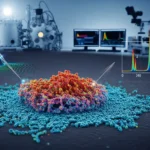In the ever-evolving landscape of technology, nanoscale devices stand at the forefront of innovation, promising to revolutionize various industries and redefine the boundaries of what is possible. These tiny yet powerful devices, engineered at the nanometer scale, exhibit unique properties and functionalities that enable groundbreaking applications in electronics, healthcare, energy, and beyond. This article delves into nanoscale devices, exploring their principles, advancements, and transformative impact on society.
Unveiling Nanoscale Devices
Nanoscale devices refer to electronic, mechanical, or optical systems engineered with components or features at the nanometer scale. These devices harness the principles of nanoscience and nanotechnology to achieve unprecedented performance, efficiency, and functionality, paving the way for next-generation technologies that push the limits of miniaturization and integration.
Principles of Nanoscale Device Design
Designing nanoscale devices involves mastering the fundamental principles of physics, chemistry, and materials science at the nanometer scale. Key considerations include:
- Size and Scale: Nanoscale devices typically range from a few to hundreds of nanometers, allowing precise control over their properties and behavior. At this scale, quantum effects, surface interactions, and confinement phenomena significantly determine device performance.
- Materials and Fabrication Techniques: Nanomaterials such as carbon nanotubes, graphene, and semiconductor nanowires serve as building blocks for nanoscale devices. Fabrication techniques such as molecular beam epitaxy, electron beam lithography, and self-assembly enable the precise manipulation and assembly of nanoscale components to create functional devices.
- Functionality and Integration: Nanoscale devices exhibit diverse functionalities, including sensing, computing, energy harvesting, and communication. Integration of multiple nanocomponents into complex systems enables the development of miniaturized, multifunctional devices with enhanced performance and versatility.
Advances in Nanoscale Device Technologies
Recent advancements in nanotechnology have led to the development of a wide range of nanoscale devices with transformative capabilities:
Nanoelectronics and Quantum Computing
Nanoscale electronics, based on novel materials and device architectures, promise to overcome the limitations of conventional silicon-based technologies. Quantum dots, spintronics, and single-electron transistors enable ultrafast, low-power computing, paving the way for quantum computing paradigms that revolutionize data processing and encryption.
Nanomedicine and Biomedical Devices
In biomedicine, nanoscale devices offer targeted drug delivery, imaging, and diagnostics with unprecedented precision and efficiency. Nanoparticles, nanosensors, and nanorobots enable minimally invasive therapies, real-time monitoring of biological processes, and personalized medicine approaches that improve patient outcomes and healthcare delivery.
Nanophotonics and Optoelectronics
Nanoscale photonic and optoelectronic devices leverage the unique properties of light at the nanometer scale to enable high-speed data transmission, sensing, and imaging. Plasmonic nanoparticles, photonic crystals, and quantum dots facilitate miniaturized, high-performance devices for telecommunications, sensing, and imaging applications.
Applications of Nanoscale Devices
Nanoscale devices find applications across diverse industries, driving innovation and addressing critical societal challenges:
Information Technology and Communication
Nanoscale devices enable faster, smaller, and more energy-efficient electronic systems in information technology. Nanoelectronic components, such as nanowires and carbon nanotube transistors, enhance the performance of computer processors, memory devices, and communication systems, enabling the development of advanced computing architectures and high-speed data networks.
Energy Conversion and Storage
Nanoscale devices are pivotal in energy conversion and storage technologies, facilitating efficient solar cells, batteries, and fuel cells. Nanomaterials, such as quantum dots and nanowires, enhance energy absorption, transport, and conversion, enabling renewable energy technologies with higher efficiency, durability, and scalability.
Environmental Monitoring and Sensing
In environmental science, nanoscale sensors and detectors enable real-time monitoring of pollutants, contaminants, and environmental parameters. Nanomaterial-based sensors offer high sensitivity, selectivity, and miniaturization, enabling distributed sensor networks for air quality monitoring, water purification, and industrial safety applications.
Future Directions and Challenges
Despite their immense potential, nanoscale devices face challenges and opportunities for further advancement:
Scalability and Manufacturing
Scaling up nanoscale device fabrication processes for mass production remains challenging due to throughput, yield, and cost-effectiveness limitations. Developing scalable manufacturing techniques and integration strategies is crucial for realizing the commercial viability of nanotechnology-based products and systems.
Safety and Regulatory Considerations
Ensuring the safety, ethical, and regulatory compliance of nanoscale devices is essential for their widespread adoption and acceptance. Research efforts focus on assessing nanomaterials’ potential risks, environmental impact, and long-term effects on human health and the ecosystem, guiding regulatory frameworks and standards for their safe use and disposal.
Interdisciplinary Collaboration and Education
Advancing nanoscale devices requires interdisciplinary collaboration among scientists, engineers, policymakers, and educators. Collaboration across disciplines and promoting nanoscience literacy and education are essential for nurturing the next generation of researchers and innovators who will drive nanotechnology’s continued development and application.
Conclusion
Nanoscale devices represent a paradigm shift in technology, offering unparalleled capabilities and opportunities for innovation across various domains. By harnessing the principles of nanoscience and engineering, nanoscale devices hold the key to addressing some of society’s most pressing challenges, from healthcare and energy to environmental sustainability and beyond. As research and development in nanotechnology continue to advance, the future promises a world transformed by the power of nanoscale devices, shaping a smarter, healthier, and more sustainable society for generations to come.





